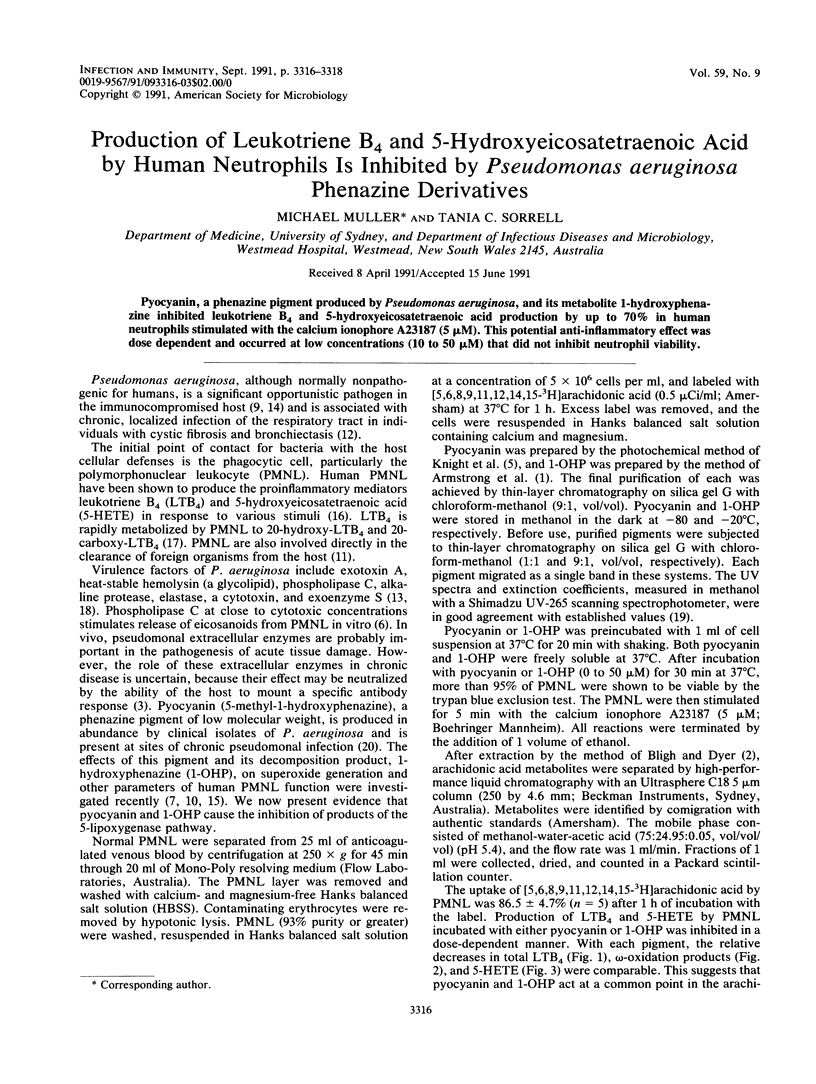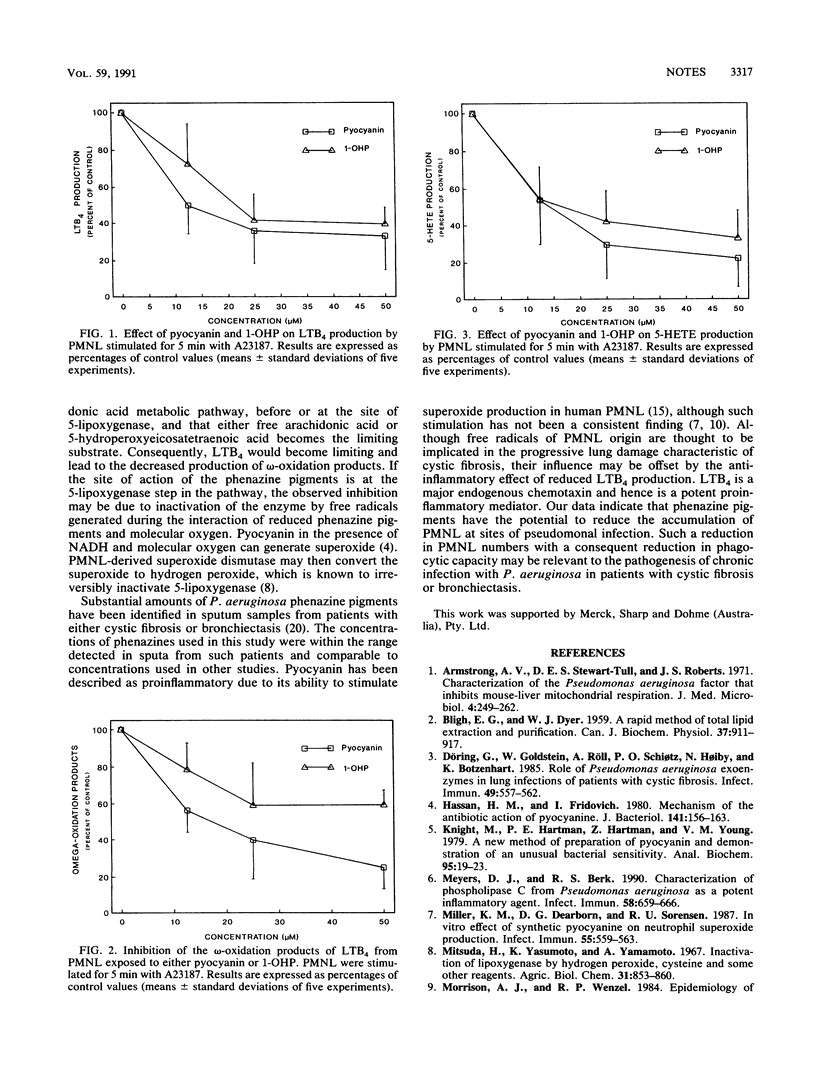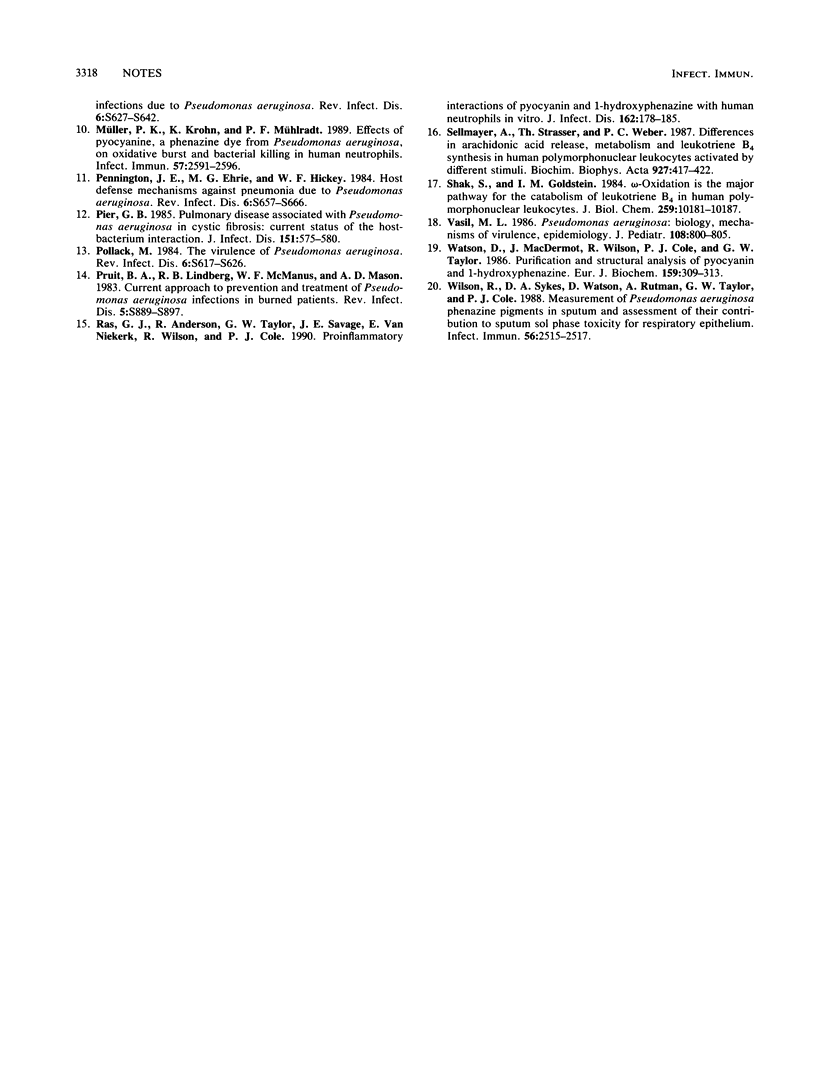Abstract
Pyocyanin, a phenazine pigment produced by Pseudomonas aeruginosa, and its metabolite 1-hydroxyphenazine inhibited leukotriene B4 and 5-hydroxyeicosatetraenoic acid production by up to 70% in human neutrophils stimulated with the calcium ionophore A23187 (5 microM). This potential anti-inflammatory effect was dose dependent and occurred at low concentrations (10 to 50 microM) that did not inhibit neutrophil viability.
Full text
PDF


Selected References
These references are in PubMed. This may not be the complete list of references from this article.
- Armstrong A. V., Stewart-Tull D. E., Roberts J. S. Characterisation of the Pseudomonas aeruginosa factor that inhibits mouse-liver mitochondrial respiration. J Med Microbiol. 1971 May;4(2):249–262. doi: 10.1099/00222615-4-2-249. [DOI] [PubMed] [Google Scholar]
- BLIGH E. G., DYER W. J. A rapid method of total lipid extraction and purification. Can J Biochem Physiol. 1959 Aug;37(8):911–917. doi: 10.1139/o59-099. [DOI] [PubMed] [Google Scholar]
- Döring G., Goldstein W., Röll A., Schiøtz P. O., Høiby N., Botzenhart K. Role of Pseudomonas aeruginosa exoenzymes in lung infections of patients with cystic fibrosis. Infect Immun. 1985 Sep;49(3):557–562. doi: 10.1128/iai.49.3.557-562.1985. [DOI] [PMC free article] [PubMed] [Google Scholar]
- Hassan H. M., Fridovich I. Mechanism of the antibiotic action pyocyanine. J Bacteriol. 1980 Jan;141(1):156–163. doi: 10.1128/jb.141.1.156-163.1980. [DOI] [PMC free article] [PubMed] [Google Scholar]
- Knight M., Hartman P. E., Hartman Z., Young V. M. A new method of preparation of pyocyanin and demonstration of an unusual bacterial sensitivity. Anal Biochem. 1979 May;95(1):19–23. doi: 10.1016/0003-2697(79)90179-9. [DOI] [PubMed] [Google Scholar]
- Meyers D. J., Berk R. S. Characterization of phospholipase C from Pseudomonas aeruginosa as a potent inflammatory agent. Infect Immun. 1990 Mar;58(3):659–666. doi: 10.1128/iai.58.3.659-666.1990. [DOI] [PMC free article] [PubMed] [Google Scholar]
- Miller K. M., Dearborn D. G., Sorensen R. U. In vitro effect of synthetic pyocyanine on neutrophil superoxide production. Infect Immun. 1987 Mar;55(3):559–563. doi: 10.1128/iai.55.3.559-563.1987. [DOI] [PMC free article] [PubMed] [Google Scholar]
- Müller P. K., Krohn K., Mühlradt P. F. Effects of pyocyanine, a phenazine dye from Pseudomonas aeruginosa, on oxidative burst and bacterial killing in human neutrophils. Infect Immun. 1989 Sep;57(9):2591–2596. doi: 10.1128/iai.57.9.2591-2596.1989. [DOI] [PMC free article] [PubMed] [Google Scholar]
- Pennington J. E., Ehrie M. G., Hickey W. F. Host defense mechanisms against pneumonia due to Pseudomonas aeruginosa. Rev Infect Dis. 1984 Sep-Oct;6 (Suppl 3):S657–S666. doi: 10.1093/clinids/6.supplement_3.s657. [DOI] [PubMed] [Google Scholar]
- Pier G. B. Pulmonary disease associated with Pseudomonas aeruginosa in cystic fibrosis: current status of the host-bacterium interaction. J Infect Dis. 1985 Apr;151(4):575–580. doi: 10.1093/infdis/151.4.575. [DOI] [PubMed] [Google Scholar]
- Pollack M. The virulence of Pseudomonas aeruginosa. Rev Infect Dis. 1984 Sep-Oct;6 (Suppl 3):S617–S626. doi: 10.1093/clinids/6.supplement_3.s617. [DOI] [PubMed] [Google Scholar]
- Pruitt B. A., Jr, Lindberg R. B., McManus W. F., Mason A. D., Jr Current approach to prevention and treatment of Pseudomonas aeruginosa infections in burned patients. Rev Infect Dis. 1983 Nov-Dec;5 (Suppl 5):S889–S897. doi: 10.1093/clinids/5.supplement_5.s889. [DOI] [PubMed] [Google Scholar]
- Ras G. J., Anderson R., Taylor G. W., Savage J. E., Van Niekerk E., Wilson R., Cole P. J. Proinflammatory interactions of pyocyanin and 1-hydroxyphenazine with human neutrophils in vitro. J Infect Dis. 1990 Jul;162(1):178–185. doi: 10.1093/infdis/162.1.178. [DOI] [PubMed] [Google Scholar]
- Sellmayer A., Strasser T., Weber P. C. Differences in arachidonic acid release, metabolism and leukotriene B4 synthesis in human polymorphonuclear leukocytes activated by different stimuli. Biochim Biophys Acta. 1987 Mar 11;927(3):417–422. doi: 10.1016/0167-4889(87)90107-8. [DOI] [PubMed] [Google Scholar]
- Shak S., Goldstein I. M. Omega-oxidation is the major pathway for the catabolism of leukotriene B4 in human polymorphonuclear leukocytes. J Biol Chem. 1984 Aug 25;259(16):10181–10187. [PubMed] [Google Scholar]
- Vasil M. L. Pseudomonas aeruginosa: biology, mechanisms of virulence, epidemiology. J Pediatr. 1986 May;108(5 Pt 2):800–805. doi: 10.1016/s0022-3476(86)80748-x. [DOI] [PubMed] [Google Scholar]
- Watson D., MacDermot J., Wilson R., Cole P. J., Taylor G. W. Purification and structural analysis of pyocyanin and 1-hydroxyphenazine. Eur J Biochem. 1986 Sep 1;159(2):309–313. doi: 10.1111/j.1432-1033.1986.tb09869.x. [DOI] [PubMed] [Google Scholar]
- Wilson R., Sykes D. A., Watson D., Rutman A., Taylor G. W., Cole P. J. Measurement of Pseudomonas aeruginosa phenazine pigments in sputum and assessment of their contribution to sputum sol toxicity for respiratory epithelium. Infect Immun. 1988 Sep;56(9):2515–2517. doi: 10.1128/iai.56.9.2515-2517.1988. [DOI] [PMC free article] [PubMed] [Google Scholar]


